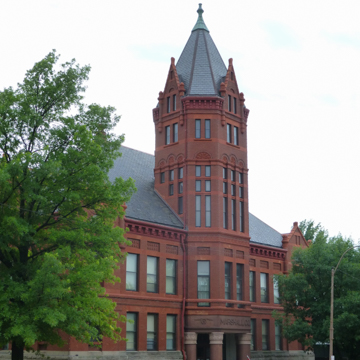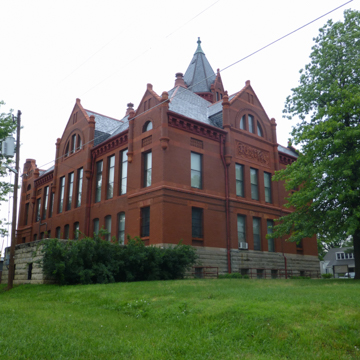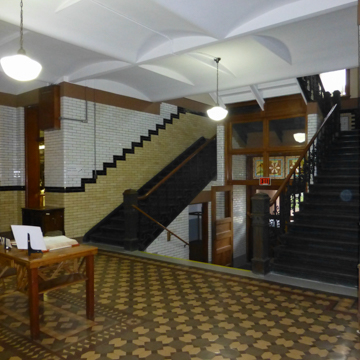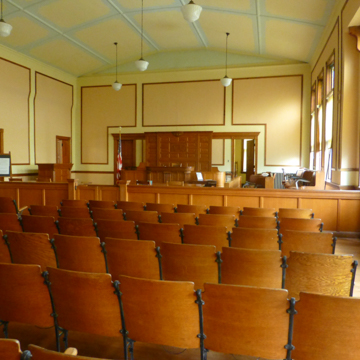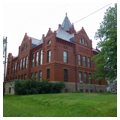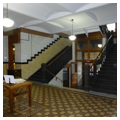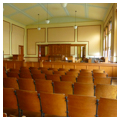You are here
Historic Marshall County Courthouse Museum and Genealogical Library
The Old Marshall County Courthouse is a proud and striking building that occupies the south side of the eastern end of Broadway Street, Marysville’s main commercial street. It is unique among Kansas courthouses in its construction and materiality.
The courthouse was designed by the prolific Milwaukee architect Henry C. Koch, who worked in a variety of historical styles and specialized in public buildings, including the design of twenty courthouses across the upper Midwest. He was a safe choice for the citizens of Marshall County. The program and function of Koch’s building is not too different from courthouses for other similarly sized Kansas counties. Mechanical and service functions are located in the lower level, set partially into the ground; the main level houses administrative offices; and the court and law enforcement facilities occupy the upper level. Romanesque Revival was a common style for Kansas courthouses of the time, but the material palette, detailing, and execution of Koch’s Richardsonian design set the Marshall County Courthouse apart. Like many Kansas buildings, the foundation and lowest level were built of locally available limestone, but above this level, unlike most similar structures, Koch’s building is rendered in monochromatic, rusty-red materials including hard-fired brick, with trim elements made of similarly colored sandstone and terra-cotta.
The body of the building consists of a singular rectilinear form with a tall hipped-roof that features strategically placed pedimented parapets. The building’s key distinguishing feature is its tower: the engaged, eight-sided, 100-foot-tall tower rises above the building’s main entrance. It is supported on four massive granite columns that create an exterior foyer for the building. Interior public spaces are faced with brightly colored enameled brick. The floors are made of decorative tiles. Shallowly vaulted masonry arches are supported on metal beams. On both the inside and outside, the building speaks of integrity, massiveness, and permanence.
This building is the county’s third courthouse. The first was a frame structure that had served as a church and a stable in the nearby town of Palmetto before being moved to Marysville in 1862 for use as a courthouse. It was replaced in 1874 by a more substantial and appropriate building. When this second courthouse burned in 1890, it was replaced by the building that is now known as the Old Courthouse. In the 1970s, county leaders began talking about replacing the county’s antiquated and inefficient third courthouse, a proposal met fervent resistance by Marysville residents. As a compromise, a one-story modern courthouse was built adjacent to the existing building, which was given over to the Marshall County Historical Society. It is now known as the Historic Marshall County Courthouse Museum and Genealogical Library and contains the offices of the Historical Society, exhibits illustrating the county’s history, and genealogical records. Despite the change in use, the interior spaces remain substantially unchanged. Key spaces and elements like the courtroom and the walk-in-safe are an integral part of the exhibits.
The Old Courthouse remains an important symbol for the City of Marysville. The city played an important role in the development of the region, and some of the artifacts exhibited in the building include a preserved stable that was used by the Pony Express and a re-creation of the kind of earthen house, or soddie, that was home to many early settlers.
References
Pankratz, Richard, “(Old) Marshall County Courthouse,” Marshall County, Kansas. National Register of Historic Places Inventory-Nomination Form, 1974. National Park Service, U.S. Department of the Interior, Washington, D.C.
Writing Credits
If SAH Archipedia has been useful to you, please consider supporting it.
SAH Archipedia tells the story of the United States through its buildings, landscapes, and cities. This freely available resource empowers the public with authoritative knowledge that deepens their understanding and appreciation of the built environment. But the Society of Architectural Historians, which created SAH Archipedia with University of Virginia Press, needs your support to maintain the high-caliber research, writing, photography, cartography, editing, design, and programming that make SAH Archipedia a trusted online resource available to all who value the history of place, heritage tourism, and learning.





